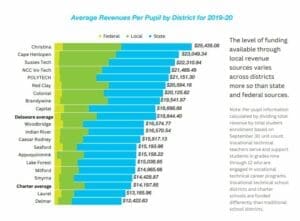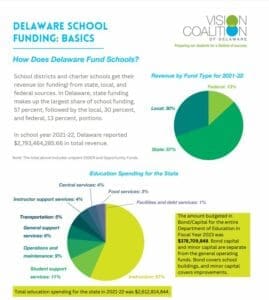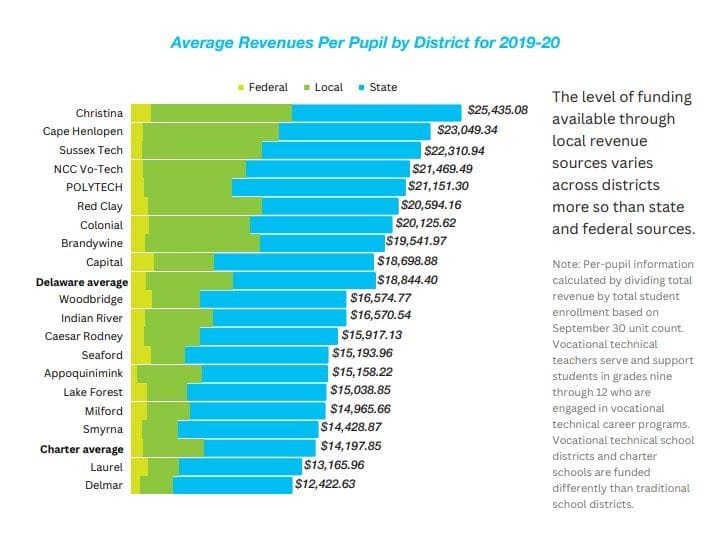
Source: Vision Coalition of Delaware
A mounting sense of anticipation surrounds Tuesday’s release of a report making suggestions about how to improve Delaware’s school funding system to make state education more equitable.
The assessment — which the state paid $700,000 for — was conducted by the national research firm American Institutes of Research.
It sprange out of the settlement of a 2020 lawsuit that charged Delaware’s 1940s funding system was shortchanging children with learning disabilities, English language learners and those from low-income homes.
In short, the problem with the state’s unusual funding system is that money doesn’t follow the students.
It essentially follows teachers, with the state funding local classrooms by unit rather than giving school districts money by child or the needs of the children in a school district.
That makes it harder for schools to provide for special attention and programs some students need to succeed, critics say.
Schools also receive local and federal money, but a lot of the federal money is funneled through the state and comes with stipulations for the way it’s spent.
The system is called a resource-based allocation, and Delaware is one of seven states that use it.
RELATED STORY: Education leaders discuss equity ahead of funding report release
The report is expected to focus on how the funding system can support all students while maintaining the strengths of the current system, which many say is local control of education.
Part of what it will do is compare Delaware’s formula to other states’.
The report won’t be short and will likely take a few hours to read and digest, say those familiar with the process.
Even so, the Vision Coalition of Delaware, Delaware Department of Education, and American Institutes of Research will hold an in-person launch of the assessment Tuesday from 9:30 a.m. to noon at Delaware Technical Community College’s Terry Campus in Dover.
Expected to speak at the launch are Delaware Secretary of Education Mark Holodick, American Institutes researcher Drew Atchison and Bettina Tweardy Riveros, chief public affairs officer and chief health equity officer of ChristianaCare.’
No one expects all recommendations to be adopted.
They come as Gov. John Carney moves into the last year of two terms as governor.
But it also comes as Delaware has a majority Democrat legislature. The Senate is able to pass anything the Democrats want to do, but House Dems still need a few votes from Republicans to pass bills that require constitutional changes.
RELATED STORY: Here’s why the state wants advice on school funding
Among other things, the Vision Coalition says the report is expected to:
- Research and understand the existing funding structure as established in Delaware Code and supported by the Annual Appropriations act.
- Assess state and local funding categories and include findings around advantages and disadvantages of the current public school funding structure.
- Evaluate all existing revenue and expenditure levels, comparing that data in a variety of meaningful ways that highlight any existing disparities. This work should include a review of staffing
compensation, and the impact of compensation on high-need schools. - Analyze public school funding structures in other states and make comparisons to Delaware’s system. This comparative analysis should include outcomes and impacts of the various funding structures and levels of funding, and include a review of state/local funding obligations.
- Include a thorough review of other funding models including (but not limited to) weighted student funding.
- Prepare and present recommendations for future improvements that may result in improved funding equities statewide, with a focus on improving outcomes for all students.
- Include recommendations with suggested timelines and options for phasing in modifications to ensure long-term sustainability.
To do all that, American Institutes has gathered primary, administrative, policy and document data and then analyzed local funding, compared Delaware’s funding to other states, looked at cost–function adequacy, examined Charter school funding, analyzed educator opnions and considered the perceptions of the current system.

Source: Vision Coalition of Delaware
School funding lawsuit
Delaware is not alone in examining how it funds schools.
Tennessee recently moved to change its funding formula to give districts a certain amount of money per student, with additional outlays for students who were low-income, special needs or
English language learners. Tennessee also gives districts incentive payments for various programs.
The march toward seeking an assessment of school funding started in 2018, when a group of reformers tired of talking and filed suits against tate and county officials, saying the system wasn’t equitable.
Plaintiffs Delawareans for Educational Opportunity and the NAACP of Delaware were represented by national law firm Arnold & Porter, the American Civil Liberties Union of Delaware and the Community Legal Aid Society.
Part of the suit was settled in 2020, with Carney agreeing to add $25 million in state Opportunity Funding to help English learners and low income students. It is expected to rise to $60 million by the 2024-2025 school year.
Even so, say some experts, that’s a fraction of what other states put into that kind of funding.
As part of the lawsuit, all three counties agreed to reassess property in light of the court’s ruling that the state’s current reliance on property values violates Delaware law and Delaware’s Constitution.
That reassessment is still underway.

Betsy Price is a Wilmington freelance writer who has 40 years of experience, including 15 at The News Journal in Delaware.
Share this Post




